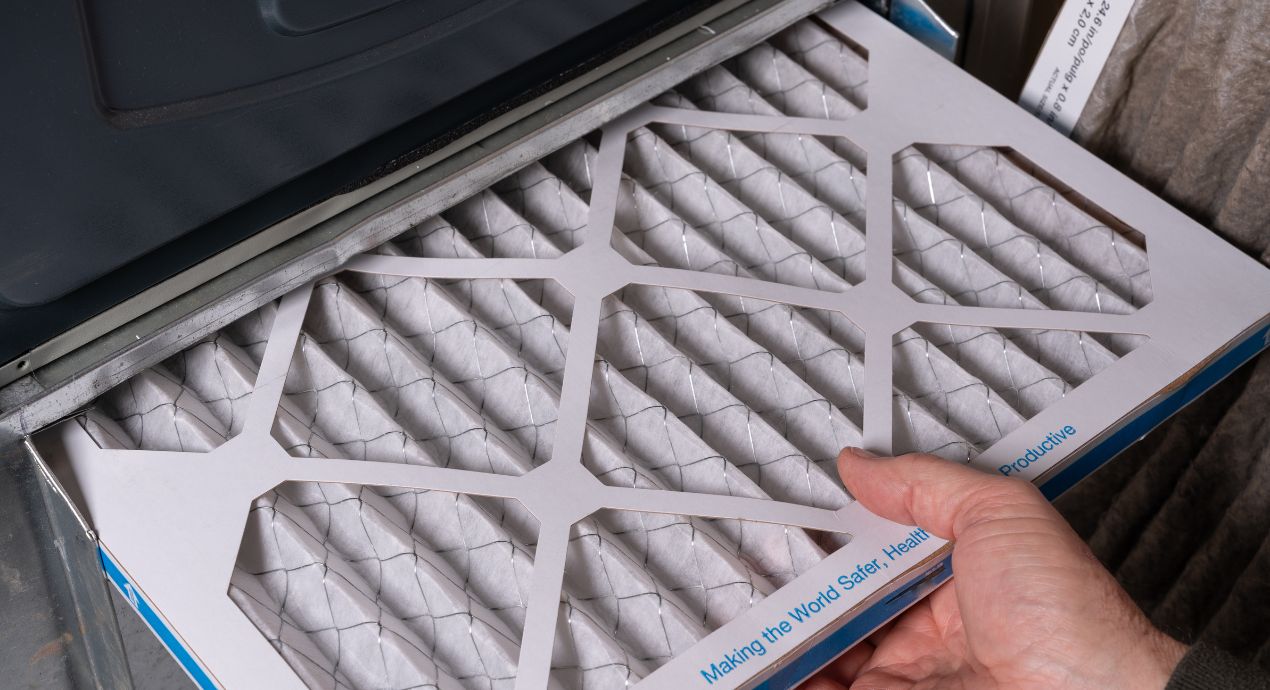
Contemplating coverage?
Subscribe to receive our emails & get
$200 off!
Have questions?
Call us: (833) 544-8273


Written By Rachel Cherem
In the realm of home comfort and efficiency, few components are as integral as your furnace. Especially during the colder months, it serves as the cornerstone of warmth and coziness. However, to maintain its optimal functionality and ensure good indoor air quality, consistent upkeep is paramount. Among the most straightforward yet impactful maintenance tasks is changing the furnace filter.
This extensive guide aims to delve deeper into the importance of this routine chore, exploring its myriad of benefits, recommending frequencies, and providing meticulous instructions for proper execution.
The furnace filter serves as a vigilant guardian against airborne contaminants like dust, pollen, pet dander, and other particulates. Over time, these particles amass on the filter, causing it to become clogged and impeding airflow. Consequently, your furnace is compelled to work overtime to maintain the desired temperature, resulting in heightened energy consumption and inflated utility bills.
Moreover, a dirty or obstructed filter can spell trouble for indoor air quality. When the filter fails to effectively capture contaminants, they circulate freely throughout your home, potentially exacerbating allergies and respiratory issues. Regularly changing your furnace filter not only bolsters HVAC system efficiency but also fosters cleaner, healthier air for you and your loved ones.
Enhanced Energy Efficiency: A clean filter facilitates optimal airflow, alleviating strain on your furnace and reducing energy consumption. This translates to tangible cost savings on utility bills over time.
Prolonged Furnace Lifespan: By lightening the workload on your furnace, a clean filter minimizes wear and tear, ultimately extending the lifespan of your heating system and diminishing the need for repairs or replacements.
Elevated Air Quality: Eliminating airborne pollutants from your home's atmosphere fosters superior indoor air quality, cultivating a healthier and more comfortable living environment, particularly for individuals with allergies or respiratory sensitivities.
Consistent Comfort: A well-maintained furnace, outfitted with a clean filter, ensures uniform heat distribution throughout your home, guaranteeing consistent comfort in every nook and cranny.
The frequency of filter changes hinges on various factors, including the type of filter, indoor air pollution levels, and manufacturer recommendations. As a general rule of thumb, it's prudent to inspect your filter monthly and replace it every 1 to 3 months. However, more frequent replacements may be warranted if:
You share your abode with shedding pets.
You dwell in an exceptionally dusty or polluted locale.
You or your family members grapple with allergies or respiratory conditions.
Recent home renovations or construction projects have transpired.
By routinely monitoring and replacing your furnace filter, you ensure optimal performance and seamless operation of your HVAC system throughout the year.
Let's delve into the step-by-step process of changing your furnace filter correctly:
Before embarking on the task, ensure you have the following tools and materials within reach:
A new furnace filter (ensuring it aligns with the correct size and type for your HVAC system)
Screwdriver (if requisite for accessing the filter compartment)
Gloves (optional, but recommended to shield your hands from dust and debris)
For safety precautions, power down your furnace before proceeding with the filter replacement. Locate the power switch on your furnace and toggle it off. Allow several minutes for the system to fully shut down before proceeding.
The filter compartment is typically situated proximate to the furnace's blower motor. Depending on your HVAC system, the filter may be housed inside the furnace unit, within a wall-mounted return air grille, or within a separate filter housing. Refer to your furnace manual or seek professional guidance if uncertain regarding its whereabouts.
Gently extract the old filter from its housing. Pay heed to its orientation and airflow direction (typically delineated by arrows on the filter frame) to ensure proper alignment of the new filter.
While the filter is removed, take a moment to scrutinize the filter housing for any accumulation of dirt, debris, or mold. Utilize a vacuum cleaner with a brush attachment to eradicate any buildup, or wipe the surface clean with a damp cloth if necessary.
Insert the new filter into the filter housing, ensuring it is meticulously aligned with the airflow arrows pointing in the designated direction. Assure that the filter fits snugly into place to obviate air leaks around the periphery.
If your furnace boasts a removable cover or door for the filter compartment, firmly affix it back into place. Employ a screwdriver if requisite to tighten any screws or clips securing the cover in situ.
Upon successful installation of the new filter and secure closure of the filter compartment, proceed to restore power to your furnace. Be attentive to any unusual noises or vibrations that may signal an installation anomaly.
Maintain a record of the filter replacement date by inscribing it on the filter frame or setting a reminder on your calendar. This practice will facilitate adherence to regular filter replacement schedules in the future.
Dispose of the old filter in accordance with local waste disposal regulations. If the filter is recyclable, ascertain whether your local recycling center accepts furnace filters for recycling.
Congratulations! You have successfully executed the replacement of your furnace filter, marking a significant stride toward augmenting your home's energy efficiency and indoor air quality.
Regular inspection and replacement of your furnace filter represent a straightforward yet efficacious strategy for upholding optimal performance and indoor air quality within your abode.
By adhering to the steps delineated in this guide and implementing a consistent maintenance regimen, you can ensure seamless operation of your HVAC system, prolong its longevity, and cultivate a healthier environment for you and your family.
There's a reason Liberty Home Guard was rated the #1 Home Warranty Service by U.S. News and World Report for 2021, 2022, 2023, and 2024. Check out our services.
Learn More
Stay Ahead of Potential
Home Mishaps!
Subscribe to our Liberty Home Guard Newsletter and gain access to exclusive content that ensures your peace of mind.